人教版Go for it 七年级上册Unit 1 My name's Gina.知识点课件(共24张PPT)
文档属性
| 名称 | 人教版Go for it 七年级上册Unit 1 My name's Gina.知识点课件(共24张PPT) | 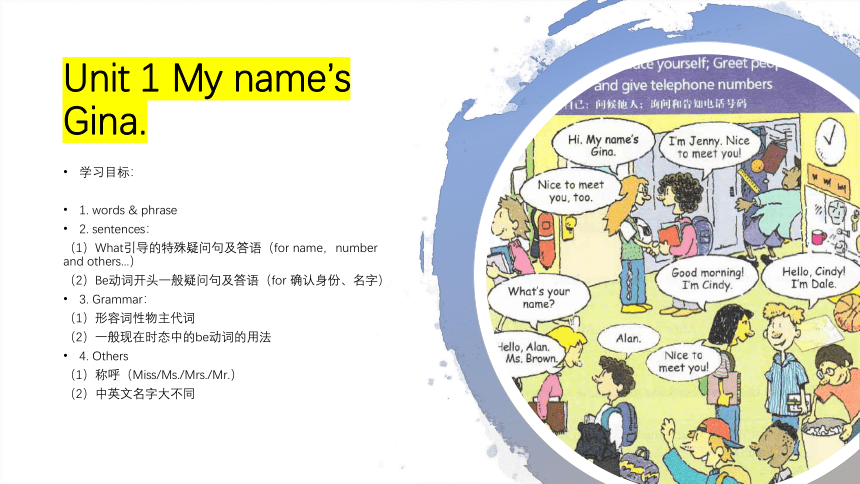 | |
| 格式 | zip | ||
| 文件大小 | 2.2MB | ||
| 资源类型 | 教案 | ||
| 版本资源 | 人教新目标(Go for it)版 | ||
| 科目 | 英语 | ||
| 更新时间 | 2020-11-30 21:39:56 | ||
图片预览

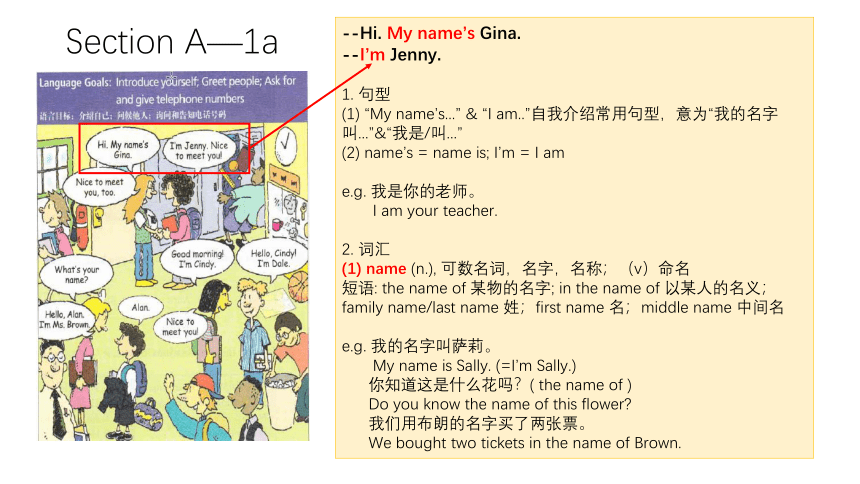
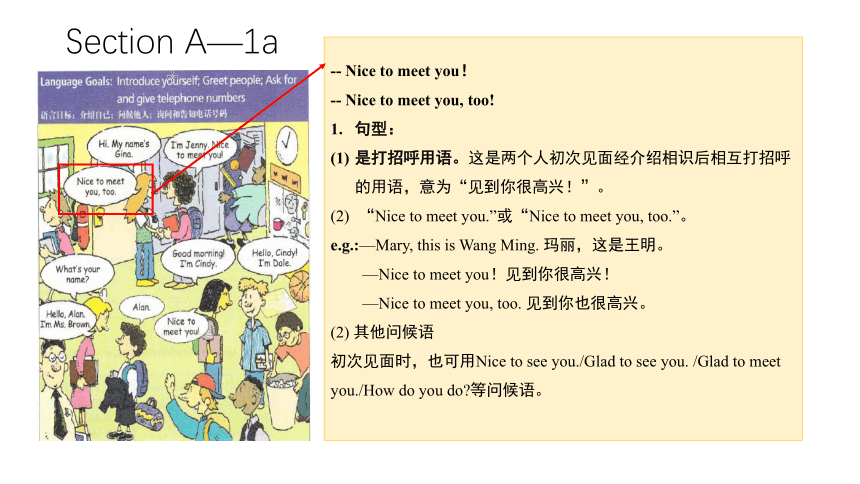
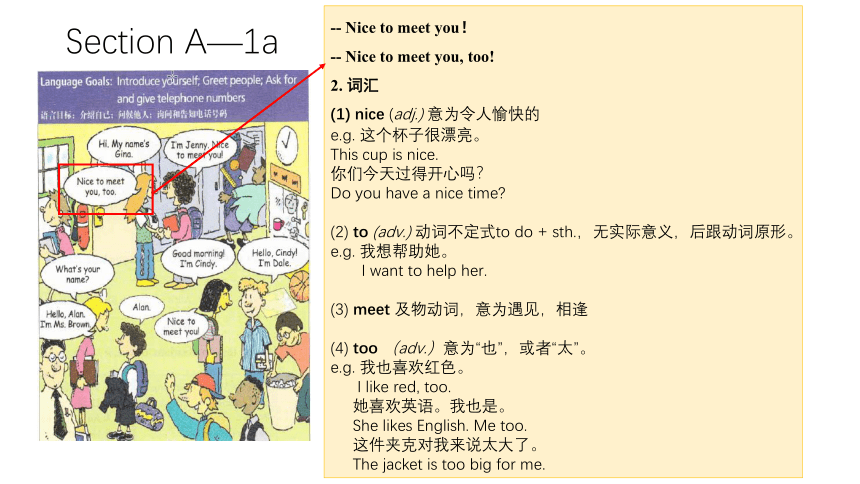
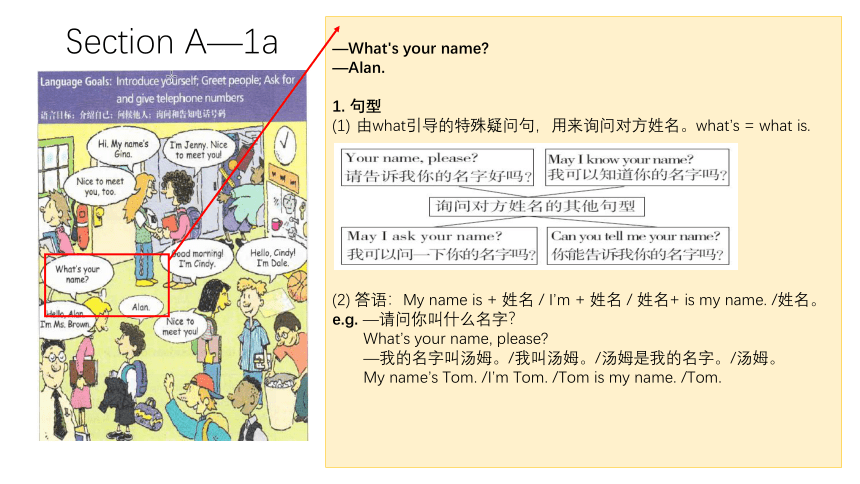
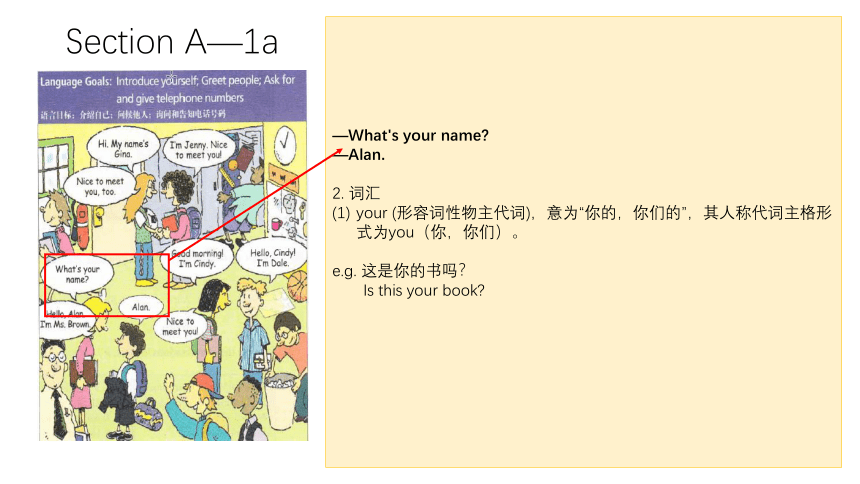
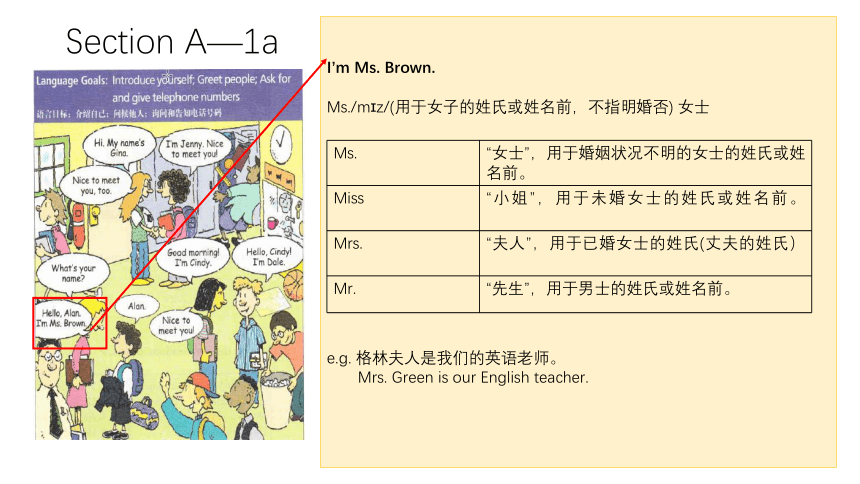


文档简介
(共24张PPT)
Unit
1
My
name’s
Gina.
学习目标:
1.
words
&
phrase
2.
sentences:
(1)What引导的特殊疑问句及答语(for
name,number
and
others...)
(2)Be动词开头一般疑问句及答语(for
确认身份、名字)
3.
Grammar:
(1)形容词性物主代词
(2)一般现在时态中的be动词的用法
4.
Others
(1)称呼(Miss/Ms./Mrs./Mr.)
(2)中英文名字大不同
Section
A—1a
--Hi.
My
name’s
Gina.
--I’m
Jenny.
1.
句型
(1)
“My
name’s...”
&
“I
am..”自我介绍常用句型,意为“我的名字叫...”&“我是/叫...”
(2)
name’s
=
name
is;
I’m
=
I
am
e.g.
我是你的老师。
I
am
your
teacher.
2.
词汇
name
(n.),
可数名词,名字,名称;(v)命名
短语:
the
name
of
某物的名字;
in
the
name
of
以某人的名义;family
name/last
name
姓;first
name
名;middle
name
中间名
e.g.
我的名字叫萨莉。
My
name
is
Sally.
(=I’m
Sally.)
你知道这是什么花吗?(
the
name
of
)
Do
you
know
the
name
of
this
flower?
我们用布朗的名字买了两张票。
We
bought
two
tickets
in
the
name
of
Brown.
Section
A—1a
--
Nice
to
meet
you!
--
Nice
to
meet
you,
too!
句型:
是打招呼用语。这是两个人初次见面经介绍相识后相互打招呼的用语,意为“见到你很高兴!”。
“Nice
to
meet
you.”或“Nice
to
meet
you,
too.”。
e.g.:—Mary,
this
is
Wang
Ming.
玛丽,这是王明。
—Nice
to
meet
you!见到你很高兴!
—Nice
to
meet
you,
too.
见到你也很高兴。
(2)
其他问候语
初次见面时,也可用Nice
to
see
you./Glad
to
see
you.
/Glad
to
meet
you./How
do
you
do?等问候语。
Section
A—1a
--
Nice
to
meet
you!
--
Nice
to
meet
you,
too!
2.
词汇
nice
(adj.)
意为令人愉快的
e.g.
这个杯子很漂亮。
This
cup
is
nice.
你们今天过得开心吗?
Do
you
have
a
nice
time?
(2)
to
(adv.)
动词不定式to
do
+
sth.,无实际意义,后跟动词原形。
e.g.
我想帮助她。
I
want
to
help
her.
(3)
meet
及物动词,意为遇见,相逢
(4)
too
(adv.)意为“也”,或者“太”。
e.g.
我也喜欢红色。
I
like
red,
too.
她喜欢英语。我也是。
She
likes
English.
Me
too.
这件夹克对我来说太大了。
The
jacket
is
too
big
for
me.
Section
A—1a
—What's
your
name?
—Alan.
1.
句型
由what引导的特殊疑问句,用来询问对方姓名。what’s
=
what
is.
(2)
答语:My
name
is
+
姓名
/
I’m
+
姓名
/
姓名+
is
my
name.
/姓名。
e.g.
—请问你叫什么名字?
What’s
your
name,
please?
—我的名字叫汤姆。/我叫汤姆。/汤姆是我的名字。/汤姆。
My
name’s
Tom.
/I’m
Tom.
/Tom
is
my
name.
/Tom.
Section
A—1a
—What's
your
name?
—Alan.
2.
词汇
your
(形容词性物主代词),意为“你的,你们的”,其人称代词主格形式为you(你,你们)。
e.g.
这是你的书吗?
Is
this
your
book?
Section
A—1a
I’m
Ms.
Brown.
Ms./m?z/(用于女子的姓氏或姓名前,不指明婚否)
女士
e.g.
格林夫人是我们的英语老师。
Mrs.
Green
is
our
English
teacher.
Ms.
“女士”,用于婚姻状况不明的女士的姓氏或姓名前。
Miss
“小姐”,用于未婚女士的姓氏或姓名前。
Mrs.
“夫人”,用于已婚女士的姓氏(丈夫的姓氏)
Mr.
“先生”,用于男士的姓氏或姓名前。
Section
A—2c
—(And)What's
his/her
name?
—
His
/Her
name’s...
1.
句型
适用于向对方询问作为第三方的男性/女性的姓名及回答。
2.
词汇
his
/
her
(pron.)
他的/她的,形容词性物主代词,后常接名词。
(2)
and
并列连词,意为“和”,常用于连接两个并列的单词、短语或句子。
e.g.
我和你都是学生。
You
and
I
are
students.
Section
A—2c
--
Are
you
Helen?Yes,
I
am.
--
Is
he
Jack?
No,
he
isn’t.
1.
句型
问句是以be动词开头的一般疑问句。
(2)
答语:
【1】Are
you
...?(you指“你”)的答语
Yes,
I
am.
/
No,
I’m
not.
【2】Are
you
...?(you指“你们”)的答语
Yes,
we
are.
/
No,
we
aren’t.
【3】Is
he
/
her
...?
Yes,
he/she
is.
/
No,
he
/
she
isn’t.
e.g.
—你们是露西和莉莉吗?
Are
you
Lucy
and
Lily?
—是的,我们是。/
不,我们不是。
Yes,
we
are./No,
we
aren’t.
(3)
Are
you...?同义句为Is
your
name...?
但答语与其不同,见下表:
问句
肯定答语
否定答语
Are
you
Tim?
Yes,
I
am.
No,
I'm
not.
Is
your
name
Tim?
Yes,
it
is.
No,
it
isn't.
Section
A—2c
--
Are
you
Helen?Yes,
I
am.
--
Is
he
Jack?
No,
he
isn’t.
2.
词汇
no
&
not
no
adv.
&
adj.
意为“不,没有,不是”,可单独使用或作形容词修饰名词。
not
adv.
意为“不,没有”,不能单独使用,常用于be动词、助动词或情态动词之后,构成否定句。
e.g.
她是你的妈妈吗?
Is
she
your
mother?
不,她不是。
No,
she
isn’t.
我没有戒尺。
I
have
no
ruler.
(做形容词)
Section
A
(一)
形容词性物主代词
概念:英语中表示所有关系的代词为无物主代词。
形容词性物主代词
物主代词
名词性物主代词
人称
人称代词
物主代词
主格
宾格
形容词性
第一人称
单数
I
me
my
复数
we
us
our
第二人称
单数
you
you
your
复数
you
you
your
第三人称
单数
he
him
his
she
her
her
it
it
its
复数
they
them
their
Section
A
(一)
形容词性物主代词
2.
形容词性物主代词用法
形容词性物主代词修饰名词,后面一般跟名词,在句中只能用作定语。
e.g.
那是他的自行车吗?
Is
that
his
bike?
你的名字是什么?
What's
your
name?
欢迎来我家。
Welcome
to
my
home.
这是她妈妈吗?
Is
this
her
mother?
(2)
形容词性物主代词与形容词一起修饰名词时,顺序为“形容词性物主代词+形容词+名词”。
e.g.
我的新书包在这儿。
My
new
bag
is
here.
(3)
形容词性物主代词不与冠词或者指示代词(this/that/these/those)连用。
e.g.这是她的钢笔。
This
is
her
pen.
(4)
形容词性物主代词与其所指代的词在人称和数上保持一致。
e.g.
这是我的姐姐。她的名字叫爱丽丝。
This
is
my
sister.
Her
name
is
Alice.
Do
you
know
the
children
over
there?
Yes.
________
names
are
Mike
and
Jane.
A.
Theirs
B.
Their
C.
Her
D.
His
3.
辨析it’s
&
its
it’s
是
it
is的缩写,its则为形容词性物主代词。
e.g.
它是一只熊猫。它的名字是欢欢。
It’s
a
panda.
Its
name
is
Huanhuan.
B
Section
A
形容词性物主代词练习
This
is
_____
book.
my
a
B.
a
my
C.
my
D.
my
the
2.
_______
ruler
is
nice.
He
B.
His
C.
He’s
D.
He
is
3.
That
is
______
jacket.
red
his
B.
she
red
C.
yellow
my
D.
her
red
4.
What’s
_______
name?
_________name
is
Dale.
A.
her;
Her
B.
his;
His
C.
his;
My
D.
your;
His
C
B
D
B
Section
A
(二)
一般现在时中be动词的用法
be的形式:be动词表示“是”,be
动词的一般现在时形式包括am,
is和are。
2.
be动词的用法
e.g.
我是埃米。
I'm
Amy.
莉莉、露西和凯特都在中国。
Lily,
Lucy
and
Kate
are
in
China.
人称
数
主语
be动词
第一人称
单数
I
am
复数
We
are
第二人称
单数
you
are
复数
you
are
第三人称
单数
he
is
she
is
it
is
复数
they
are
Section
A
3.
缩写:
I
am=I’m
he/she/it
is=he’s/she’s/it’s
we/you/they
are
=
we’re/you’re/they’re
is
not
=
isn’t
are
not
=
aren’t
who
is
=
who’s
who
are
=
who’re
what
is
=
what’s
4.
be动词在一般现在时态中的各种句型
e.g.
她是我的妈妈。
She
is
my
mom.
她不是我的妈妈。
She
is
not
(isn’t)
my
mom.
她是你的妈妈吗?
Is
she
your
mom?
她是谁?
Who
is
she?
句式
结构
肯定句
主语+be+其他.
否定句
主语+be+not+其他.
一般问句
Be+主语+其他?
特殊疑问句
特殊疑问词+be+主语(+其他).
顺口溜:
我用am,你用are,is连着他、她、它,单数is复数are。
变否定,很容易,be
后not加上去。
变疑问,要调换,将be移至主语前,句子开头应大写,句末问号莫忘添。
Section
A
be动词练习—用am/is/are填空
What
color
______
the
cup?
2.
His
jacket
______
on
the
bed.
3.
Jack
and
I
______
good
friends.
4.
His
brother’s
first
name
______
Jack.
5.
How
______
you?
I
____
fine,
thanks.
is
is
am
is
are
are
拓展---完形填空解答技巧(一)主谓一致判断法
I
have
a
good
friend.
Her
name
__1__
Mary.
She
__2__
an
English
girl.
Her
last
name
is
Green.
We
__3__
in
the
same
school.
A.
am
B.
is
C.
are
D.
be
2.
A.
am
B.
is
C.
are
D.
be
3.
A.
am
B.
is
C.
are
D.
be
B
B
C
Section
B—1a
zero,
one,
two,
nine...
英语中的数词分基数词和序数词两类。
基数词--英语中表示数目的多少的词叫基数词。用法如下:
2.
序数词--表示事物的先后顺序的词叫序数词,如first第一,second第二,third第三,
fourth
第四,fifth第五......序数词常与定冠词the连用。
?
e.g.
我有两把钥匙。
I
have
two
keys.
第二辆自行车是我的。
The
second
bike
is
mine.
How
many
hours
do
you
sleep
every
night?
About
____
hours.
From
9:00
p.m.
to
6:00
a.m.
A.
nine
B.
nineteen
C.
ninth
D.
ninety
A
Section
B—1c
What’s
your
telephone
number,
Li
Xin?
1.
句型:
(1)
What
is
+
one’s
telephone
number?
what引导的特殊疑问句,用于询问对方的电话号码,意为
“你的电话是多少?”
(2)
答语:It’s...
/
One’s
telephone
number
is
...
/
电话号码
Section
B—2a
What’s
your
first/last
name?
词汇:
first
first
name中,first用作形容词,意思是“最初的,首先的,首要的,第一的”,常用来作定语。
e.g.
首要的事情是学好英语。
The
first
thing
is
to
learn
English
well.
(2)
first用作序数词,常与定冠词the连用。但如果first前有形容词性物主代词(my,
your,
his,
her等)时,则不加the。
e.g.
星期一是一星期中的第一天。(Monday,week)
Monday
is
the
first
day
of
a
week.
这是我的第一本哈利波特。
This
is
my
first
Harry
Potter.
last
(1)
last
name中last用作形容词,意为“最后的,末尾的”
e.g.
十二月是一年中的最后一个月。(December,month)
December
is
the
last
month
of
a
year.
Section
B—2a
中文名字和英文名字的不同表达方式:
(1)
中文名字:姓在前,名在后
Wang
Junkai
last
name
first
name
family
name(姓)
given
name(名)
e.g.
他叫王俊凯。王是他的姓。俊凯是他的名。
His
name
is
Wang
Junkai.
Wang
is
his
family
name.
Junkai
is
his
first
name.
(2)
英文名字:名在前,姓在后
Tom
Green
first
name
last
name
given
name(名)
family
name(姓)
e.g.
这是汤姆·格林。汤姆是他的名字。格林是他的姓。
This
is
Tom
Green.
Tom
is
his
first/given
name.
Green
is
his
family/last
name.
?
Section
B—2a
中国人姓名的拼写注意以下几点:
(1)如果是单姓,名只一个字,则姓与名的第一个字母要大写,其余字母要小写,中间隔开。
e.g.
Wang
Meng王蒙
(2)如果是单姓,名有两个字,则姓的第一个字母大写,名的第一个字母也大写,名的两个拼音要合在一起,且后一个拼音的第一个字母要小写。
e.g.
Zhai
Zhigang翟志刚
(3)如果是复姓,则把复姓字母连在一起,但第一个字母要大写,名字的拼写方法同上面一样。
e.g.
Ouyang
Xiadan
欧阳夏丹
Zhuge
Liang诸葛亮
(4)如果名字里有可能造成音的混淆的拼写时,要用连字符“?”或间隔号“'”隔开。
e.g.
Zhao
Tian'an
赵天安
Section
B—2b
My
friend
is
in
China.
1.
句型:sb.
+
be动词+in+地点.
表示“某人在某地”。
be动词形式要与前面的主语在数上保持一致。
e.g.
我的父母在美国。
My
parents
are
in
U.S.A.
2.
词汇
(1)
friend
n.
可数名词
常见短语:
make
friends
交朋友
e.g.
我的姐姐喜欢交朋友。
My
sister
likes
making
friends.
Unit
1--练习
一、用所给单词的适当形式填空。
What’s
______
(she)
name?
2.
My
_____
(one)
name
is
David.
3.
Nice
______
(meet)
you.
4.
Her
jacket
_______
(be)
yellow.
二、句型转换
1.
I
am
Nick.
(改为同义句)
______
_______
Nick.
2.
His
name
is
Mike.
(就画线部分提问)
___________________________
3.
I
am
Jack
Brown.
(改为一般疑问句)
________
_______
Jack
Brown?
4.
His
first
name
is
Jack.
(就画线部分提问)
_______
________
first
name?
first
her
to
is
My
name
What’s
his
name?
Are
you
What’s
his
Unit
1—作文自我介绍
本单元的话题为“结交朋友”,与此相关的写作人物常围绕“自我介绍”展开。
作文要点:
要用第一人称
2.介绍自己的个人情况,包括姓名、电话等。除此之外还可以拓展到学校、爱好(朋友)等。常用句型:
My
name/first
name/
last
name
is
...
My
telephone
number
is
...
3.
写作练习:假设你是Lucy
Brown。明天早上有英语课,请根据下表中的内容提示向你的同学做自我介绍。
Name
Lucy
Brown
Phone
Number
887-9864
Hobby(爱好)
Reading
Friend
Gina
Smith
Unit
1
My
name’s
Gina.
学习目标:
1.
words
&
phrase
2.
sentences:
(1)What引导的特殊疑问句及答语(for
name,number
and
others...)
(2)Be动词开头一般疑问句及答语(for
确认身份、名字)
3.
Grammar:
(1)形容词性物主代词
(2)一般现在时态中的be动词的用法
4.
Others
(1)称呼(Miss/Ms./Mrs./Mr.)
(2)中英文名字大不同
Section
A—1a
--Hi.
My
name’s
Gina.
--I’m
Jenny.
1.
句型
(1)
“My
name’s...”
&
“I
am..”自我介绍常用句型,意为“我的名字叫...”&“我是/叫...”
(2)
name’s
=
name
is;
I’m
=
I
am
e.g.
我是你的老师。
I
am
your
teacher.
2.
词汇
name
(n.),
可数名词,名字,名称;(v)命名
短语:
the
name
of
某物的名字;
in
the
name
of
以某人的名义;family
name/last
name
姓;first
name
名;middle
name
中间名
e.g.
我的名字叫萨莉。
My
name
is
Sally.
(=I’m
Sally.)
你知道这是什么花吗?(
the
name
of
)
Do
you
know
the
name
of
this
flower?
我们用布朗的名字买了两张票。
We
bought
two
tickets
in
the
name
of
Brown.
Section
A—1a
--
Nice
to
meet
you!
--
Nice
to
meet
you,
too!
句型:
是打招呼用语。这是两个人初次见面经介绍相识后相互打招呼的用语,意为“见到你很高兴!”。
“Nice
to
meet
you.”或“Nice
to
meet
you,
too.”。
e.g.:—Mary,
this
is
Wang
Ming.
玛丽,这是王明。
—Nice
to
meet
you!见到你很高兴!
—Nice
to
meet
you,
too.
见到你也很高兴。
(2)
其他问候语
初次见面时,也可用Nice
to
see
you./Glad
to
see
you.
/Glad
to
meet
you./How
do
you
do?等问候语。
Section
A—1a
--
Nice
to
meet
you!
--
Nice
to
meet
you,
too!
2.
词汇
nice
(adj.)
意为令人愉快的
e.g.
这个杯子很漂亮。
This
cup
is
nice.
你们今天过得开心吗?
Do
you
have
a
nice
time?
(2)
to
(adv.)
动词不定式to
do
+
sth.,无实际意义,后跟动词原形。
e.g.
我想帮助她。
I
want
to
help
her.
(3)
meet
及物动词,意为遇见,相逢
(4)
too
(adv.)意为“也”,或者“太”。
e.g.
我也喜欢红色。
I
like
red,
too.
她喜欢英语。我也是。
She
likes
English.
Me
too.
这件夹克对我来说太大了。
The
jacket
is
too
big
for
me.
Section
A—1a
—What's
your
name?
—Alan.
1.
句型
由what引导的特殊疑问句,用来询问对方姓名。what’s
=
what
is.
(2)
答语:My
name
is
+
姓名
/
I’m
+
姓名
/
姓名+
is
my
name.
/姓名。
e.g.
—请问你叫什么名字?
What’s
your
name,
please?
—我的名字叫汤姆。/我叫汤姆。/汤姆是我的名字。/汤姆。
My
name’s
Tom.
/I’m
Tom.
/Tom
is
my
name.
/Tom.
Section
A—1a
—What's
your
name?
—Alan.
2.
词汇
your
(形容词性物主代词),意为“你的,你们的”,其人称代词主格形式为you(你,你们)。
e.g.
这是你的书吗?
Is
this
your
book?
Section
A—1a
I’m
Ms.
Brown.
Ms./m?z/(用于女子的姓氏或姓名前,不指明婚否)
女士
e.g.
格林夫人是我们的英语老师。
Mrs.
Green
is
our
English
teacher.
Ms.
“女士”,用于婚姻状况不明的女士的姓氏或姓名前。
Miss
“小姐”,用于未婚女士的姓氏或姓名前。
Mrs.
“夫人”,用于已婚女士的姓氏(丈夫的姓氏)
Mr.
“先生”,用于男士的姓氏或姓名前。
Section
A—2c
—(And)What's
his/her
name?
—
His
/Her
name’s...
1.
句型
适用于向对方询问作为第三方的男性/女性的姓名及回答。
2.
词汇
his
/
her
(pron.)
他的/她的,形容词性物主代词,后常接名词。
(2)
and
并列连词,意为“和”,常用于连接两个并列的单词、短语或句子。
e.g.
我和你都是学生。
You
and
I
are
students.
Section
A—2c
--
Are
you
Helen?Yes,
I
am.
--
Is
he
Jack?
No,
he
isn’t.
1.
句型
问句是以be动词开头的一般疑问句。
(2)
答语:
【1】Are
you
...?(you指“你”)的答语
Yes,
I
am.
/
No,
I’m
not.
【2】Are
you
...?(you指“你们”)的答语
Yes,
we
are.
/
No,
we
aren’t.
【3】Is
he
/
her
...?
Yes,
he/she
is.
/
No,
he
/
she
isn’t.
e.g.
—你们是露西和莉莉吗?
Are
you
Lucy
and
Lily?
—是的,我们是。/
不,我们不是。
Yes,
we
are./No,
we
aren’t.
(3)
Are
you...?同义句为Is
your
name...?
但答语与其不同,见下表:
问句
肯定答语
否定答语
Are
you
Tim?
Yes,
I
am.
No,
I'm
not.
Is
your
name
Tim?
Yes,
it
is.
No,
it
isn't.
Section
A—2c
--
Are
you
Helen?Yes,
I
am.
--
Is
he
Jack?
No,
he
isn’t.
2.
词汇
no
&
not
no
adv.
&
adj.
意为“不,没有,不是”,可单独使用或作形容词修饰名词。
not
adv.
意为“不,没有”,不能单独使用,常用于be动词、助动词或情态动词之后,构成否定句。
e.g.
她是你的妈妈吗?
Is
she
your
mother?
不,她不是。
No,
she
isn’t.
我没有戒尺。
I
have
no
ruler.
(做形容词)
Section
A
(一)
形容词性物主代词
概念:英语中表示所有关系的代词为无物主代词。
形容词性物主代词
物主代词
名词性物主代词
人称
人称代词
物主代词
主格
宾格
形容词性
第一人称
单数
I
me
my
复数
we
us
our
第二人称
单数
you
you
your
复数
you
you
your
第三人称
单数
he
him
his
she
her
her
it
it
its
复数
they
them
their
Section
A
(一)
形容词性物主代词
2.
形容词性物主代词用法
形容词性物主代词修饰名词,后面一般跟名词,在句中只能用作定语。
e.g.
那是他的自行车吗?
Is
that
his
bike?
你的名字是什么?
What's
your
name?
欢迎来我家。
Welcome
to
my
home.
这是她妈妈吗?
Is
this
her
mother?
(2)
形容词性物主代词与形容词一起修饰名词时,顺序为“形容词性物主代词+形容词+名词”。
e.g.
我的新书包在这儿。
My
new
bag
is
here.
(3)
形容词性物主代词不与冠词或者指示代词(this/that/these/those)连用。
e.g.这是她的钢笔。
This
is
her
pen.
(4)
形容词性物主代词与其所指代的词在人称和数上保持一致。
e.g.
这是我的姐姐。她的名字叫爱丽丝。
This
is
my
sister.
Her
name
is
Alice.
Do
you
know
the
children
over
there?
Yes.
________
names
are
Mike
and
Jane.
A.
Theirs
B.
Their
C.
Her
D.
His
3.
辨析it’s
&
its
it’s
是
it
is的缩写,its则为形容词性物主代词。
e.g.
它是一只熊猫。它的名字是欢欢。
It’s
a
panda.
Its
name
is
Huanhuan.
B
Section
A
形容词性物主代词练习
This
is
_____
book.
my
a
B.
a
my
C.
my
D.
my
the
2.
_______
ruler
is
nice.
He
B.
His
C.
He’s
D.
He
is
3.
That
is
______
jacket.
red
his
B.
she
red
C.
yellow
my
D.
her
red
4.
What’s
_______
name?
_________name
is
Dale.
A.
her;
Her
B.
his;
His
C.
his;
My
D.
your;
His
C
B
D
B
Section
A
(二)
一般现在时中be动词的用法
be的形式:be动词表示“是”,be
动词的一般现在时形式包括am,
is和are。
2.
be动词的用法
e.g.
我是埃米。
I'm
Amy.
莉莉、露西和凯特都在中国。
Lily,
Lucy
and
Kate
are
in
China.
人称
数
主语
be动词
第一人称
单数
I
am
复数
We
are
第二人称
单数
you
are
复数
you
are
第三人称
单数
he
is
she
is
it
is
复数
they
are
Section
A
3.
缩写:
I
am=I’m
he/she/it
is=he’s/she’s/it’s
we/you/they
are
=
we’re/you’re/they’re
is
not
=
isn’t
are
not
=
aren’t
who
is
=
who’s
who
are
=
who’re
what
is
=
what’s
4.
be动词在一般现在时态中的各种句型
e.g.
她是我的妈妈。
She
is
my
mom.
她不是我的妈妈。
She
is
not
(isn’t)
my
mom.
她是你的妈妈吗?
Is
she
your
mom?
她是谁?
Who
is
she?
句式
结构
肯定句
主语+be+其他.
否定句
主语+be+not+其他.
一般问句
Be+主语+其他?
特殊疑问句
特殊疑问词+be+主语(+其他).
顺口溜:
我用am,你用are,is连着他、她、它,单数is复数are。
变否定,很容易,be
后not加上去。
变疑问,要调换,将be移至主语前,句子开头应大写,句末问号莫忘添。
Section
A
be动词练习—用am/is/are填空
What
color
______
the
cup?
2.
His
jacket
______
on
the
bed.
3.
Jack
and
I
______
good
friends.
4.
His
brother’s
first
name
______
Jack.
5.
How
______
you?
I
____
fine,
thanks.
is
is
am
is
are
are
拓展---完形填空解答技巧(一)主谓一致判断法
I
have
a
good
friend.
Her
name
__1__
Mary.
She
__2__
an
English
girl.
Her
last
name
is
Green.
We
__3__
in
the
same
school.
A.
am
B.
is
C.
are
D.
be
2.
A.
am
B.
is
C.
are
D.
be
3.
A.
am
B.
is
C.
are
D.
be
B
B
C
Section
B—1a
zero,
one,
two,
nine...
英语中的数词分基数词和序数词两类。
基数词--英语中表示数目的多少的词叫基数词。用法如下:
2.
序数词--表示事物的先后顺序的词叫序数词,如first第一,second第二,third第三,
fourth
第四,fifth第五......序数词常与定冠词the连用。
?
e.g.
我有两把钥匙。
I
have
two
keys.
第二辆自行车是我的。
The
second
bike
is
mine.
How
many
hours
do
you
sleep
every
night?
About
____
hours.
From
9:00
p.m.
to
6:00
a.m.
A.
nine
B.
nineteen
C.
ninth
D.
ninety
A
Section
B—1c
What’s
your
telephone
number,
Li
Xin?
1.
句型:
(1)
What
is
+
one’s
telephone
number?
what引导的特殊疑问句,用于询问对方的电话号码,意为
“你的电话是多少?”
(2)
答语:It’s...
/
One’s
telephone
number
is
...
/
电话号码
Section
B—2a
What’s
your
first/last
name?
词汇:
first
first
name中,first用作形容词,意思是“最初的,首先的,首要的,第一的”,常用来作定语。
e.g.
首要的事情是学好英语。
The
first
thing
is
to
learn
English
well.
(2)
first用作序数词,常与定冠词the连用。但如果first前有形容词性物主代词(my,
your,
his,
her等)时,则不加the。
e.g.
星期一是一星期中的第一天。(Monday,week)
Monday
is
the
first
day
of
a
week.
这是我的第一本哈利波特。
This
is
my
first
Harry
Potter.
last
(1)
last
name中last用作形容词,意为“最后的,末尾的”
e.g.
十二月是一年中的最后一个月。(December,month)
December
is
the
last
month
of
a
year.
Section
B—2a
中文名字和英文名字的不同表达方式:
(1)
中文名字:姓在前,名在后
Wang
Junkai
last
name
first
name
family
name(姓)
given
name(名)
e.g.
他叫王俊凯。王是他的姓。俊凯是他的名。
His
name
is
Wang
Junkai.
Wang
is
his
family
name.
Junkai
is
his
first
name.
(2)
英文名字:名在前,姓在后
Tom
Green
first
name
last
name
given
name(名)
family
name(姓)
e.g.
这是汤姆·格林。汤姆是他的名字。格林是他的姓。
This
is
Tom
Green.
Tom
is
his
first/given
name.
Green
is
his
family/last
name.
?
Section
B—2a
中国人姓名的拼写注意以下几点:
(1)如果是单姓,名只一个字,则姓与名的第一个字母要大写,其余字母要小写,中间隔开。
e.g.
Wang
Meng王蒙
(2)如果是单姓,名有两个字,则姓的第一个字母大写,名的第一个字母也大写,名的两个拼音要合在一起,且后一个拼音的第一个字母要小写。
e.g.
Zhai
Zhigang翟志刚
(3)如果是复姓,则把复姓字母连在一起,但第一个字母要大写,名字的拼写方法同上面一样。
e.g.
Ouyang
Xiadan
欧阳夏丹
Zhuge
Liang诸葛亮
(4)如果名字里有可能造成音的混淆的拼写时,要用连字符“?”或间隔号“'”隔开。
e.g.
Zhao
Tian'an
赵天安
Section
B—2b
My
friend
is
in
China.
1.
句型:sb.
+
be动词+in+地点.
表示“某人在某地”。
be动词形式要与前面的主语在数上保持一致。
e.g.
我的父母在美国。
My
parents
are
in
U.S.A.
2.
词汇
(1)
friend
n.
可数名词
常见短语:
make
friends
交朋友
e.g.
我的姐姐喜欢交朋友。
My
sister
likes
making
friends.
Unit
1--练习
一、用所给单词的适当形式填空。
What’s
______
(she)
name?
2.
My
_____
(one)
name
is
David.
3.
Nice
______
(meet)
you.
4.
Her
jacket
_______
(be)
yellow.
二、句型转换
1.
I
am
Nick.
(改为同义句)
______
_______
Nick.
2.
His
name
is
Mike.
(就画线部分提问)
___________________________
3.
I
am
Jack
Brown.
(改为一般疑问句)
________
_______
Jack
Brown?
4.
His
first
name
is
Jack.
(就画线部分提问)
_______
________
first
name?
first
her
to
is
My
name
What’s
his
name?
Are
you
What’s
his
Unit
1—作文自我介绍
本单元的话题为“结交朋友”,与此相关的写作人物常围绕“自我介绍”展开。
作文要点:
要用第一人称
2.介绍自己的个人情况,包括姓名、电话等。除此之外还可以拓展到学校、爱好(朋友)等。常用句型:
My
name/first
name/
last
name
is
...
My
telephone
number
is
...
3.
写作练习:假设你是Lucy
Brown。明天早上有英语课,请根据下表中的内容提示向你的同学做自我介绍。
Name
Lucy
Brown
Phone
Number
887-9864
Hobby(爱好)
Reading
Friend
Gina
Smith
同课章节目录
- starters 预备篇(2012秋审查)
- Unit 1 Good morning !
- Unit 2 What’s this in English?
- Unit 3 What color is it ?
- Unit 1 My name's Gina.
- Section A
- Section B
- Unit 2 This is my sister.
- Section A
- Section B
- Unit 3 Is this your pencil?
- Section A
- Section B
- Unit 4 Where's my schoolbag?
- Section A
- Section B
- Unit 5 Do you have a soccer ball?
- Section A
- Section B
- Unit 6 Do you like bananas?
- Section A
- Section B
- Unit 7 How much are these socks?
- Section A
- Section B
- Unit 8 When is your birthday?
- Section A
- Section B
- Unit 9 My favorite subject is science.
- Section A
- Section B
